7. April 2022 By Ilias El Haouati, Simon Bächle and Ellen Szczepaniak
Renewable energies are too volatile – is a blackout imminent?
The expansion of renewable energies in Germany
The goal that drives the expansion of renewable energies (RE) is to cover at least 80 per cent of Germany’s electricity demand by 2050. The main impetus for reaching these goals is to protect the climate and the environment. Due to the current conflict with Russia, another argument is gaining in importance: the desire to end our dependency on fossil fuels.
The expansion of renewable energies in Germany has seen the output of green energy increase from around 11 gigawatts to around 148 gigawatts within 22 years. The current data on the installed power plant capacity of renewable energies for the year 2022 is presented in the following table.
| Energy source | Installed capacity (GW) |
| Hydroelectric power plants (run-of-river power plants) | 4,94 |
| Pumped storage | 9,80 |
| Battery storage | 0,58 |
| Biomass | 56,51 |
| Wind (onshore) | 56,51 |
| Wind (offshore) | 7,77 |
| Solar | 59,40 |
With a load profile of around 70 gigawatts in Germany, it could be assumed that this country already obtains 100 per cent of its electricity from renewable sources. So far, this is only the case on a few days or during a few hours each year, because RE has a volatile generation structure, which means that when there are lulls (for example, clouds in the sky), the amount of power generated is reduced. The remaining load that can’t be covered by RE is called ‘residual load’. This must continue to be covered by conventional power plants (combined cycle power plants or coal power plants). Only a few RE power plants are not reliant on the weather, for instance, biomass plants and (run-of-river) hydroelectric power plants. In order to obtain a secure power supply from 100 per cent RE, capacities must be expanded more intensively. At the same time, renewable energies have to cover the base load. The following figure shows a scenario for the future power supply in Germany. In the year 2021, approximately 233 terawatt hours of electricity were generated using RE. This corresponds to about 41 per cent of the total consumption. The current target is for RE to cover 80 per cent of the power supply by 2050.
Effects of the volatile feed-in of RE on frequency
In the German power grid, the mains frequency must be kept stable within a defined range.
What is the mains frequency?
The mains frequency can be compared to a scale. On the one hand, we have the producers who generate electricity, and, on the other hand, the consumers who use electricity. To keep the system in balance, the amount of electricity consumed should be equal to the amount produced.
From a technical point of view, the term ‘mains frequency’ refers to the required frequency of the alternating current used to generate electronic power. In Germany and for the European power grid, the mains frequency is 50 Hertz (Hz), and in the USA, it’s 60 Hz. Theoretically, you can measure the current mains frequency in Germany at any socket; or you can look at this website.
So what effects do renewable energies have on the mains frequency?
If all power plants (regardless of whether they’re conventional or renewable) simultaneously produce more electricity than consumers use, the electricity production of certain power plants is minimised or even completely shut down. This is done in a set order. If a power plant should fail unexpectedly, the mains frequency will become unbalanced again. At this point in time, more electricity is consumed than produced. To prevent this, the capacity of certain power plants is ramped up.
If the grid frequency deviates by 0.02 Hz, what’s called the primary control reserve is deployed. The feed-in is reduced or increased depending on whether the deviation is positive or negative. These deviations are mostly controlled by conventional large power plants (> 100-megawatt capacity) or smaller hydroelectric power plants.
Unlike conventional power plants, renewable energies can be controlled at any time. A coal-fired power plant, for example, needs between two and eight hours to fully start up. These power plants can’t just be switched on or off like a car. Gas-fired power plants are much easier to control. These power plants need 15 minutes to become fully operable and are therefore also used to balance peak loads, as they’re able to be controlled quickly and provide the necessary power. Hydroelectric power plants, on the other hand, can increase or reduce output every second. These power plants also include pumped-storage and compressed air energy storage plants.
A few years ago, solar plants had to switch off their power when an overfrequency occurred. This is no longer conceivable due to the broad expansion of photovoltaic plants and their contribution to electricity production. Therefore, these systems only start to reduce their output beginning at a frequency of 50.2 Hz, and they only shut down at an overfrequency of 51.5 Hz.
Step-by-step measures to protect the frequency
| Level | Frequency | Measures for compensation or protection |
| 1 | 49,8 Hz | Use balancing energy |
| 2 | 49,0 Hz | Immediately shed 10–15% of the mains load |
| 3 | 48,7 Hz | Immediately shed an additional 10–15% of the mains load |
| 4 | 48,4 Hz | Immediately shed an additional 15–20% of the mains load |
| 5 | 47,5 Hz | Disconnect the power plants from the grid |
What is a blackout, and what does it mean for you as citizens?
In the energy industry, a blackout means a large-scale power supply failure that lasts for several minutes. This results in a total power outage. In contrast to a blackout, in what’s known as a ‘brownout’, the grid is protected from excessive load requirements by specifically disconnecting certain loads. To do this, large electricity consumers, or even entire city districts, are taken off the grid in succession. However, as a rule, industry is taken off the grid first – before private households are sequentially taken off the grid in rolling succession. This is why a brownout is also known as the harbinger of a blackout. In such an emergency, the transmission system operators are obliged to maintain the stability of the electricity grid (see Section 13(2) EnWG [German Energy Industry Act – Energiewirtschaftsgesetz]).
How does a blackout like this happen?
A blackout happens when the voltage of the power grid falls below 47.5 Hz (compared to the usual 50 Hz). A reason for this can be a lack of RE plants, which leads to an increase in the residual load that cannot be compensated by conventional energy sources. The grid operators have contingency plans in place should this increase occur. The focus is always on restoring the grid supply as quickly as possible.
The typical restoration procedure is briefly outlined in the following: First, switching and control commands or similar measures are used to target systems relevant to restoring the grid in order to obtain active and reactive power for the restoration – for example, from neighbouring grids. In this process, the de-energised grid is by no means immediately restored to normal operation; rather, it’s started up gradually in isolated mode. What’s known as a black start can be used to start up large power plants in order to restore the grid.
Black start-capable power plants must have the following characteristics:
- Ability to start up quickly and flexibly
- Only in-plant power and no external power sources
- Ability to withstand heavy starting currents
- Stagnation – continuous self-sufficient operation
Hydroelectric power plants, gas-fired power plants or compressed air energy storage power plants are generally best suited for this.
The danger of a blackout
Low natural gas reserves, the phasing out of nuclear and coal-fired power and the volatile feed-in of renewable energies increase the risk of a blackout. In addition to the volatile feed-in, there is also the unpredictable use of electricity by sectors such as the electromobility industry. This causes the peak loads to become increasingly larger and more unpredictable towards the end of the working day. The long distances between electricity producers and their consumers are also problematic.
Rapidly expanding the grid nationwide as well as expanding storage facilities (thermal or electrochemical storage facilities or hydroelectric power) can contribute to minimising the risk of a blackout.
Measures for maintaining frequency stability are an important part of our power supply and serve to minimise the occurrence of blackouts. These measures are currently mainly carried out by large power plants. Newer, more modern and more efficient wind turbines will also assume this task in coming years. What’s more, virtual power plants will also be able to provide balancing energy in the future and contribute to reducing the probability of a blackout.
The following figure also shows a decline in outage times of the German power supply.

Duration of power supply interruptions in Germany
You can find more exciting topics from the adesso world in our blog articles published so far.




